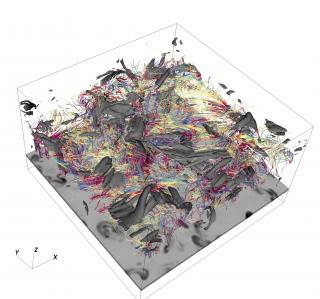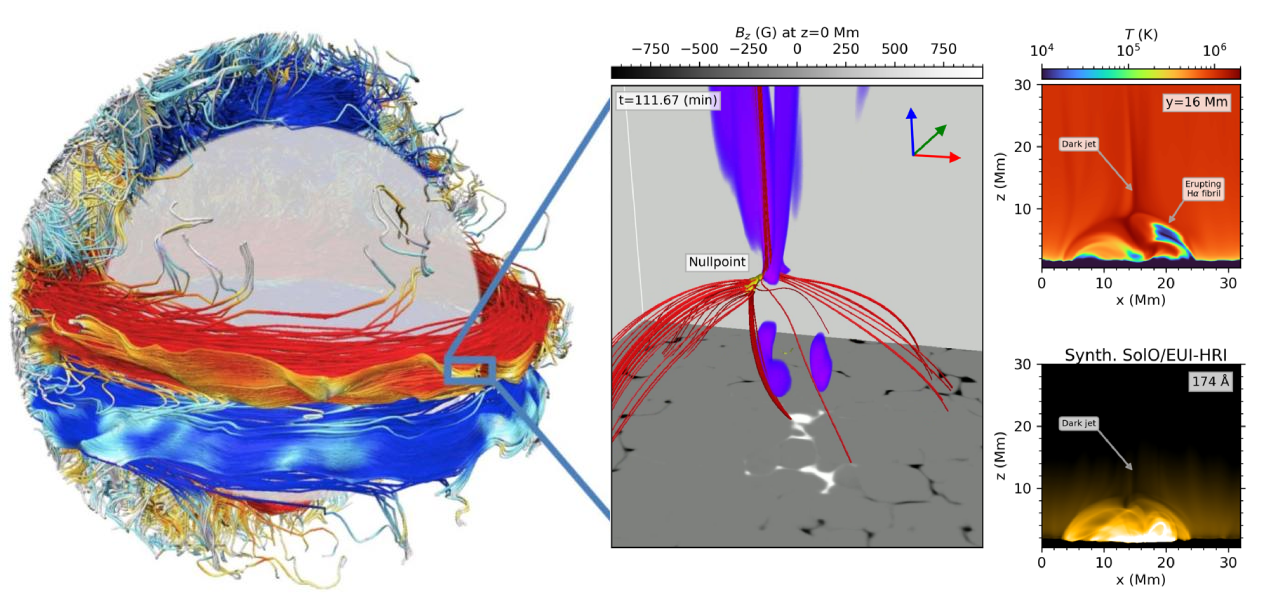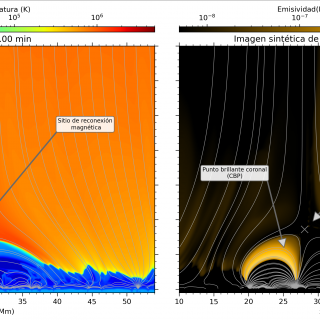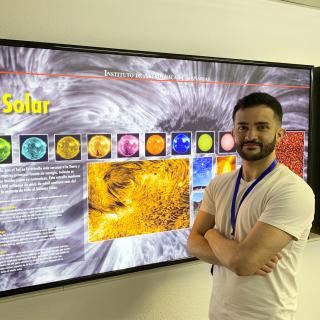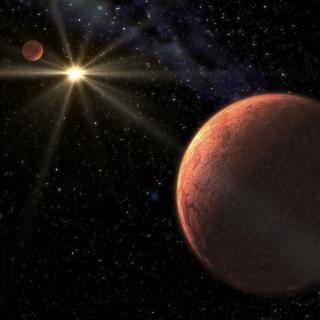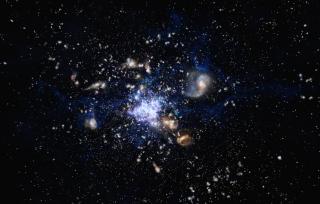General
The Sun is a magnetically active star with violent eruptions that can hit Earth´s magnetosphere and cause important perturbations in our technology-dependent society. The objective of the Whole Sun project is to tackle in a coherent way for the first time key questions in Solar Physics that involve as a whole the solar interior and the atmosphere. Our star, the Sun, is a magnetically active celestial body. Its atmosphere undergoes violent eruptions, which are difficult to predict. The largest eruptions, after traversing the interplanetary space, can hit and deform Earth´s magnetosphere and cause important perturbations in our technology-dependent society.
The intense research in solar astrophysics in the past decades has produced important advancement in the knowledge of the solar structure and dynamics. Yet, there remain fundamental questions without a fully satisfactory answer, like: which processes in the interior lead to the generation of the solar magnetic field and why does the Sun have a magnetic activity cycle? What exactly is the mechanism leading to the giant magnetic eruptions seen in its atmosphere? What is the mutual relationship between the interior and the atmosphere? The objective of The Whole Sun project is to tackle these key questions that concern simultaneously the interior and the atmosphere as a coherent whole for the first time.
Until now, the research on the Sun had been carried out through the separate study of its interior, the low atmosphere and the corona, without a global, integrated vision of the complex dynamics that links the plasma in those regions. To understand and provide quantitative explanations for the physical processes in them one has to use advanced concepts of fluid dynamics, electromagnetism, kinetic theory and, additionally for the atmosphere, radiation-matter interaction; one has to apply refined techniques of theoretical and numerical modeling using massively parallel supercomputing installations; one must also carry out and interpret observations acquired in the advanced telescope installations on the ground and in space available at present. The Whole Sun project brings together five European institutions with leading solar physics research groups; we want to attain a deeper understanding of our star by linking the physics of its interior and atmosphere. To achieve that goal, we have to overcome important hurdles like: simultaneous consideration of very different space and time scales; challenging coupling of microphysics effects next to continuum physics and global effects; bringing together and coupling computer codes that were created separately with a specific region in mind. Our goal is to tackle these problems through the development of deep theoretical understanding of our star and the construction of the most advanced solar code of multiple space and time resolution attainable at present.
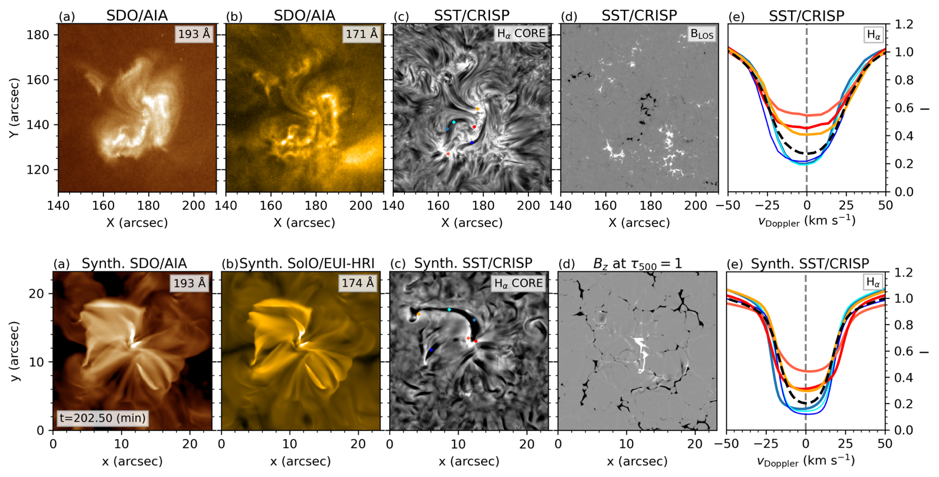
Members
Results
Highlights:
Solar atmosphere ejections.
There are still many open questions concerning key ejections in the solar atmosphere such as coronal jets, surges or spicules. We have addressed different aspects of these phenomena. For instance, we have showed that the characteristics of observed surges and kernels (plasmoids) that accompany coronal jets, as well as the detected double-chambered structures, show striking similarities with numerical jet models (Joshi et al. 2020). We have also studied the impact of coronal jets on prominences both from the theoretical side through 2.5D numerical simulations (Luna & Moreno-Insertis, 2021) and from multi-wavelength observations (Joshi et al. 2023), obtaining results that are in general agreement. With respect to surges, we have characterized for the first time the chromospheric and transition region properties of these phenomena combining high-resolution observations and advanced techniques such as k-means, inversions and density diagnostics (Nóbrega-Siverio et al. 2021). In addition, we have involved in the understanding of the coronal and transition region responses to the recently reported chromospheric downflowing rapid red shifted excursions (RREs, Bose et al. 2021). More recently, we have used coordinated SST, IRIS and SDO observations to analyze an ephemeral magnetic flux emergence episode and the following chain of small-scale energetic events, demonstrating the importance of high-resolution magnetograms in revealing the mechanisms that trigger phenomena such as EB, UV bursts and surges (Nóbrega-Siverio et al. 2024).
Nonequilibrium and partial ionization.
We have studied the effects of nonequilibrium and partial ionization in the dynamics and thermodynamics of new magnetized plasma emerging from the solar interior through numerical experiments (Nóbrega-Siverio et al. 2020a). To that end, it was necessary to implement a new Fortran module in the Bifrost code that calculates the ambipolar diffusion term in the Generalized Ohm's Law in an efficient way (Nóbrega-Siverio et al. 2020b). Recently, we have explored the ambipolar diffusion term from a more fundamental and mathematical perspective, finding new sets of self-similar solutions that can be used as demanding tests for MHD codes that include the ambipolar diffusion term, both in cylindrical coordinates (Moreno-Insertis et al. 2022) and in cartesian ones (Moreno-Insertis et al. to be submitted).
Coronal Bright Points (CBPs).
We have recently presented a comprehensive 3D radiative-MHD model using the Bifrost code of a CBP based on a magnetic nullpoint configuration, a common topology related to this kind of phenomena. We have shown that CBPs can be energized, for at least several hours, through the continuous action of stochastic photospheric convective motions, thus obviating the need for major, organized photospheric flows such as converging flows or large-scale surface flows. We have also detected continuous upflows with faint EUV signal related to the CBP, resembling observational dark coronal jets, and small-scale eruptions when chromospheric fibrils interact with the reconnection site (Nóbrega-Siverio et al. 2023).
We have also explored the chromospheric counterpart of CBPs, from observations as well as simulations, providing further understanding on the heating of the plasma confined in the small-scale loops of the CBPs and on the chromosphere underneath CBPs (Madjarska et al. 2021, Bose et al. 2023, Nóbrega-Siverio and Moreno-Insertis 2022).
Magnetic reconnection.
In this project we have also implemented different resistivity models to the radiate-MHD Bifrost code to study their impact in the magnetic reconnection process and to study which one is more suitable to reproduce solar features (Faerder et al. 2023, Faeder et al. 2024a, Faeder et al. 2024b, in revision).
Solar satellites.
We have contributed to the review of the Interface Region Imaging Spectrograph (IRIS, De Pontieu et al. 2021), focusing on the key aspects that this satellite has contributed to the better understanding of the formation and impact of spicules and other jets.
In addition to that, we have contributed in two papers related to the Multi-slit Solar Explorer (MUSE), which is a proposed NASA MIDEX mission. Our role has been providing synthetic observables from our realistic simulations with the aim of showing the potential capabilities of diagnostics of the mission (see De Pontieu et al. 2022 and Cheung et al. 2022).
Scientific activity
Related publications
-
A comparative study of resistivity models for simulations of magnetic reconnection in the solar atmosphere. II. Plasmoid formationContext. Plasmoid-mediated reconnection plays a fundamental role in different solar atmospheric phenomena. Numerical reproduction of this process is therefore essential for developing robust solar models. Aims: Our goal is to assess plasmoid-mediated reconnection across various numerical resistivity models in order to investigate how plasmoidFærder, Ø. H. et al.
Advertised on:
32024 -
Deciphering Solar Coronal Heating: Energizing Small-scale Loops through Surface ConvectionThe solar atmosphere is filled with clusters of hot small-scale loops commonly known as coronal bright points (CBPs). These ubiquitous structures stand out in the Sun by their strong X-ray and/or extreme-ultraviolet (EUV) emission for hours to days, which makes them a crucial piece when solving the solar coronal heating puzzle. In addition, theyNóbrega-Siverio, D. et al.
Advertised on:
122023 -
A comparative study of resistivity models for simulations of magnetic reconnection in the solar atmosphereContext. Magnetic reconnection is a fundamental mechanism in astrophysics. A common challenge in mimicking this process numerically in particular for the Sun is that the solar electrical resistivity is small compared to the diffusive effects caused by the discrete nature of codes. Aims: We aim to study different anomalous resistivity models andFærder, Ø. H. et al.
Advertised on:
72023 -
Interaction of solar jets with filaments: Triggering of large-amplitude filament oscillationsContext. Large-amplitude oscillations (LAOs) are often detected in filaments. Using multi-wavelength observations, their origin can be traced back to the interaction with eruptions and jets. Aims: We present two different case studies as observational evidence in support of 2.5D numerical magnetohydrodynamics (MHD) experiments that show that theJoshi, Reetika et al.
Advertised on:
42023 -
The Chromosphere Underneath a Coronal Bright PointCoronal bright points (CBPs) are sets of small-scale coronal loops, connecting opposite magnetic polarities, primarily characterized by their enhanced extreme-ultraviolet (EUV) and X-ray emission. Being ubiquitous, they are thought to play an important role in heating the solar corona. We aim at characterizing the barely explored chromosphereBose, Souvik et al.
Advertised on:
22023 -
A 2D Model for Coronal Bright Points: Association with Spicules, UV Bursts, Surges, and EUV Coronal JetsCoronal bright points (CBPs) are ubiquitous structures in the solar atmosphere composed of hot small-scale loops observed in extreme-ultraviolet (EUV) or X-rays in the quiet Sun and coronal holes. They are key elements to understanding the heating of the corona; nonetheless, basic questions regarding their heating mechanisms, the chromosphereNóbrega-Siverio, D. et al.
Advertised on:
82022 -
Ambipolar diffusion: Self-similar solutions and MHD code testing. Cylindrical symmetryContext. Ambipolar diffusion is a process occurring in partially ionised astrophysical systems that imparts a complicated mathematical and physical nature to Ohm's law. The numerical codes that solve the magnetohydrodynamic (MHD) equations have to be able to deal with the singularities that are naturally created in the system by the ambipolarMoreno-Insertis, F. et al.
Advertised on:
62022 -
Probing the Physics of the Solar Atmosphere with the Multi-slit Solar Explorer (MUSE). I. Coronal HeatingThe Multi-slit Solar Explorer (MUSE) is a proposed mission composed of a multislit extreme ultraviolet (EUV) spectrograph (in three spectral bands around 171 Å, 284 Å, and 108 Å) and an EUV context imager (in two passbands around 195 Å and 304 Å). MUSE will provide unprecedented spectral and imaging diagnostics of the solar corona at high spatial (De Pontieu, Bart et al.
Advertised on:
22022 -
Probing the Physics of the Solar Atmosphere with the Multi-slit Solar Explorer (MUSE). II. Flares and EruptionsCurrent state-of-the-art spectrographs cannot resolve the fundamental spatial (subarcseconds) and temporal (less than a few tens of seconds) scales of the coronal dynamics of solar flares and eruptive phenomena. The highest-resolution coronal data to date are based on imaging, which is blind to many of the processes that drive coronal energeticsCheung, Mark C. M. et al.
Advertised on:
22022 -
Solar surges related to UV bursts. Characterization through k-means, inversions, and density diagnosticsContext. Surges are cool and dense ejections typically observed in chromospheric lines and closely related to other solar phenomena such as UV bursts or coronal jets. Even though surges have been observed for decades now, questions regarding their fundamental physical properties such as temperature and density, as well as their impact on upperNóbrega-Siverio, D. et al.
Advertised on:
112021 -
Evidence of the multi-thermal nature of spicular downflows. Impact on solar atmospheric heatingContext. Spectroscopic observations of the emission lines formed in the solar transition region commonly show persistent downflows on the order of 10−15 km s −1. The cause of such downflows, however, is still not fully clear and has remained a matter of debate. Aims: We aim to understand the cause of such downflows by studying the coronal andBose, Souvik et al.
Advertised on:
102021 -
Large-amplitude Prominence Oscillations following Impact by a Coronal JetObservational evidence shows that coronal jets can hit prominences and set them in motion. The impact leads to large-amplitude oscillations (LAOs) in the prominence. In this paper, we attempt to understand this process via 2.5D MHD numerical experiments. In our model, the jets are generated in a sheared magnetic arcade above a parasitic bipolarLuna, Manuel et al.
Advertised on:
52021 -
The chromospheric component of coronal bright points. Coronal and chromospheric responses to magnetic-flux emergenceContext. We investigate the chromospheric counterpart of small-scale coronal loops constituting a coronal bright point (CBP) and its response to a photospheric magnetic-flux increase accompanied by co-temporal CBP heating. Aims: The aim of this study is to simultaneously investigate the chromospheric and coronal layers associated with a CBP, and inMadjarska, Maria S. et al.
Advertised on:
22021 -
Case study of multi-temperature coronal jets for emerging flux MHD modelsContext. Hot coronal jets are a basic observed feature of the solar atmosphere whose physical origin is still actively debated. Aims: We study six recurrent jets that occurred in active region NOAA 12644 on April 4, 2017. They are observed in all the hot filters of AIA as well as cool surges in IRIS slit-jaw high spatial and temporal resolutionJoshi, Reetika et al.
Advertised on:
72020 -
Ambipolar diffusion in the Bifrost codeContext. Ambipolar diffusion is a physical mechanism related to the drift between charged and neutral particles in a partially ionized plasma that is key to many different astrophysical systems. However, understanding its effects is challenging due to basic uncertainties concerning relevant microphysical aspects and the strong constraints itNóbrega-Siverio, D. et al.
Advertised on:
62020 -
Nonequilibrium ionization and ambipolar diffusion in solar magnetic flux emergence processesContext. Magnetic flux emergence from the solar interior has been shown to be a key mechanism for unleashing a wide variety of phenomena. However, there are still open questions concerning the rise of the magnetized plasma through the atmosphere, mainly in the chromosphere, where the plasma departs from local thermodynamic equilibrium (LTE) and isNóbrega-Siverio, D. et al.
Advertised on:
12020
Related talks
No related talks were found.Related conferences
No related conferences were found.